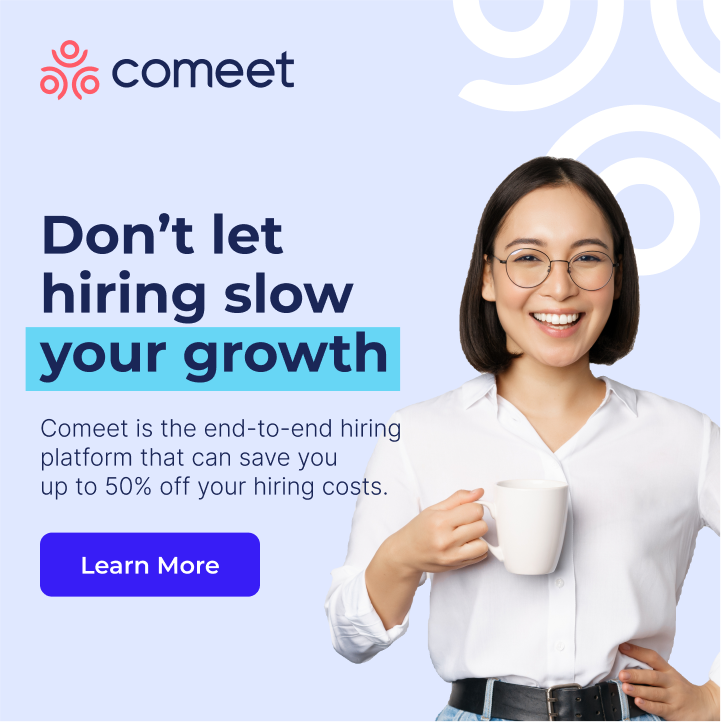The U.S. Bureau of Labor Statistics reveals that, as of April 29, 2022, there were 11.4 million job openings and 6.6 million hires. There were 6.0 million separations reported, and of those, 4.4 million were classified as “quits.”
Full cycle recruiting, also known as full life cycle recruiting or more commonly as recruiting, is a tough job in any economy. Since COVID-19, it has become increasingly complex to navigate.
Recruiting, hiring, onboarding, and turnover are being impacted in different ways in each unique industry. The economic factors that affect various industries, and the methods to find someone with the unique skill set for each, take time to research and understand.
If you are looking for a “one size fits all” answer, the best approach is to get to know more about full cycle recruiting. It saves both time and money, in more ways than one.
In this article, you will explore what full-cycle recruiting is, and why it will make such a big impact on your business.
The longer you wait, the longer your time to hire is, so let’s get started right away so you can scale your team!
What is Full Cycle Recruiting?
It’s another term for end-to-end recruitment. It describes a holistic recruitment process. Often, one recruiter will handle it, who owns every part of the talent acquisition process.
A full cycle recruiter for a small to medium-sized business handles:
- Sourcing
- Screening
- Interview Scheduling
- Reference Check
- Offer
Compared to a large corporation, full cycle recruiting can mean you have a large hiring team. The larger team has experts that handle different pieces of the process. They can have a recruitment coordinator, dedicated sourcer, and so on and so forth.
In a small or medium-sized business, they may not have enough hiring volume to justify over one individual handling it all. A full cycle recruiter becomes a jack-of-all-trades.
The Full Cycle Recruiting Process
The process will vary, depending on the position and the employer. However, here are the five steps to the full cycle recruiting process.
- Preparing
- Sourcing
- Screening
- Selecting
- Hiring
- Onboarding
Here, there is more detail on each of these steps.
1. Preparing
This refers to identifying what the hiring need is. A good recruiter or specialist will typically work with the hiring manager to identify what the ideal candidate would be, but a great recruiter will ask questions about what business problem the hiring manager is trying to solve or opportunity they’re trying to take advantage of. They will also discuss the proper qualifications that are necessary to perform the job duties successfully.
In this stage, the recruiter will create a job description that is inclusive. The recruiter will post it where necessary to attract candidates, such as on social media, job boards, and referral programs.
According to LinkedIn, the number one source for quality hires is an employee referral. Also, LinkedIn reveals that most people find a new job because of a referral.
Overall, it is important for the recruiter and hiring manager to have strong communication. It is the hiring manager who will be the final decision maker in selecting the new hire for most companies, but some will hire with a more democratic decision-making process by using a hiring team. Early alignment with the hiring manager is key for full cycle recruiters.
2. Sourcing
This is the step in the recruiting process when you compile a strong list of applicants to evaluate. With hard-to-fill roles, there may not be an abundance of applicants. Recruiters would then reach out to “passive candidates.”
These are individuals not actively searching for a job but could be interested in at least learning more about a role and a company. Today, over 73% of job seekers are passive job seekers.
This means leveraging sourcing tools or researching candidates manually who have the right skills or experience. The sourcer or recruiter will personalize a communication, inviting a person to schedule an introductory call with the recruiter or apply through email, text, LinkedIn, or another channel.
Usually, this means revisiting past applicants or connections in their talent pool so that they could re-engage who can be a good fit currently.
Recent statistics reveal that acquiring skilled candidates is difficult for as much as 72% of employers.
Full cycle recruiters overcome such obstacles. They look to metrics to help them optimize how many inbound applicants they get.
It is important to make the application process effortless. These specialists will use tools like resume parsing, adjusting ad spend, or adding new channels that make it easy to apply, like texting to apply.
3. Screening
This is how applicants progress if they are a potential fit. Also, if an applicant does not meet the qualifications necessary, they will disposition them. Often, a full cycle recruiter will perform this duty by reviewing a resume and conducting a phone screen.
Today, you find that hiring teams are leaning toward chatbots to pre-screen applicants. They can ask the tough questions up front, which is quicker than the usual 15–30-minute phone screen. Plus, these types of phone screens mean making appointments and schedules. This is a risky approach for passive candidates and hard-to-fill positions; like Software Engineers.
On-demand interviews are becoming more popular. They are replacing the manager’s phone screen. This way, an employer can prioritize candidates much more efficiently. On-demand interviews are where a candidate is sent questions that they respond to via video recording.
Recruiters and hiring managers can watch an on-demand interview anytime, anywhere.
4. Selecting
Once the hiring manager and the full cycle recruiter select the top candidates, the full cycle recruiter will schedule time with the decision-makers to meet the final list of candidates. The full cycle recruiter has the responsibility to ensure that the decision-makers have structure to make their final decision.
This means that decisions that are made are compliant, consistent, and based on predicting how well the candidate will do in future role performance. It is critical to have consistency because otherwise, a hiring manager can make a biased decision. This means training is necessary for the interviewers.
Focusing on job-relevant questions is imperative. Evaluation rubrics, scorecards, and templates with recommended questions are helpful for this.
5. Hiring
The full cycle recruiter will meet with the hiring manager to help them make a hiring decision that is informed. Upon selecting the top candidate, they will make the individual a job offer.
From this point on, the recruiter will take care of reference checks, background checks, negotiations, and settling on a start date. The full cycle recruiter takes care of logistics and paperwork.
Essentially, the recruiter serves as a liaison between the candidate and the employer.
6. Onboarding
Now that all paperwork is complete, onboarding is the next step in the process for the new hire. The full cycle recruiter will help the new hire with pre-boarding if there is not a designated HR person to run this part of the process. If there’s an HR person or team, then they’ll usually take over as the point of contact once the offer is signed
The full cycle recruiter has spent a lot of time and the employer has spent money to get this far in the process. It is important that the new hire arrives on their first day. Ghosting employers has been a problem that is increasing.
Ghosting is a term that refers to ending all contact and communication with an employer or an individual without a justification or a warning. It is a practice of ignoring the employer or individual when they attempt to reach out or communicate.
Not only do you want the new hire to arrive on day one and communicate well with your organization, but you also want them to engage in onboarding activities. That is why the full cycle recruiter will not only welcome the new hire on their first day but remain as a point of contact to help the employee with questions along with the beginning of their journey with the employer.
When you offer an onboarding experience that is efficient and includes impeccable communication, your new hire will remain with your company and add value.
Benefits of Full Cycle Recruiting
You want to offer a better candidate experience, increase accountability, and decrease your time to hire. As an employer, you can achieve all of this with end-to-end recruiting.
One Person Contact
A single point of contact is a tremendous benefit for improving the candidate experience. It is easy to understand how having one individual helps a candidate feel better about the employer. The experience you give during the recruitment process indicates how the person will feel working for you.
When you speak to multiple people and you have a question, but you can’t remember who the right go-to person is for the answer, that can be extremely frustrating.
Job searches and applications can be stressful for candidates. Knowing that they have one person to guide them throughout the process is comforting. It’s a way to create a meaningful relationship with a candidate, even during a time with so much virtual interaction.
It is more personalized. When candidates have a positive experience from the beginning, it will make all the difference once they are on board and contributing to the organization.
Increase Accountability
When you have many people involved in the process, it’s hard to keep certain individuals accountable for certain tasks. Something may go array and pinpointing the problem becomes a gray area.
With full cycle recruiting, there is one person in charge of the complete process. This means that it is clear who is responsible, too.
Further, you will want the person in charge to be rigorous and well-organized in managing the recruitment process.
Streamlining the Hiring Process
When you have one person with full control of the recruiting process, it gives them the opportunity to streamline. It sets the full cycle recruiter up for success. That is because one person is hands-on and has control over each step along with the recruitment and hiring cycle.
A full cycle recruiter who owns the process can move at their own pace. It helps to give the person in charge flexibility, which also helps increase the chances of a faster, more qualified hire.
Decreased Time to Hire
Measuring how many days it takes from a candidate applying for a job opening at your company to the same person accepting a job offer is known as “apply to hire.” This kind of calculation with your metrics tells of the employer’s recruiting efficiency.
If it is taking a long time to hire, then not only do you have a slow process, but it is likely inefficient too. There can be bottlenecks that are unnecessary.
When you have one person assigned to full cycle recruiting, this helps speed up the process too by lowering the chances of delays. Trading emails and playing phone tag, deciding who should do what can take up valuable time.
Better Candidate Experience
Candidates get frustrated when it takes a long time to decide if you will hire them or not. That’s why active job seekers are always applying to multiple employers. A candidate cannot afford to sit around and wait for your decision.
Think about it from your perspective if you were applying for a job. What would you prefer, that the employer take two weeks to decide if they will hire you or three months?
The faster your process is, the better the candidate will feel about their experiences with you and this will help build employee loyalty later on as well as your employer brand.
Better Quality of Hire
While employers like to hear that they are decreasing their time-to-hire, it is not enough in cost savings. You want to measure the quality of your hires.
An enormous challenge for recruitment professionals is finding a qualified candidate. Particularly, small companies can struggle in this arena of hiring.
With one full cycle recruiter, which is giving a personalized experience to applicants, they can use a more thorough process of vetting candidates. This means the employer is better equipped to land a qualified candidate for the role.
More qualified candidates are the key to growth and success for the employer overall.
Achieve Better Results
Anyone looking to improve and revamp their recruiting strategy should look to full cycle recruiting for better results.
According to Human Resources Director, recruitment professionals list these items as the top five recruiting priorities:
- Diversity hiring–22%
- Growing talent pipeline–22%
- Improving time-to-hire–23%
- Increasing retention rate–24%
- Improving quality of hire–52%
You can achieve all of this through full cycle recruiting. When you give an individual an opportunity to be more powerful and successful, everyone in the organization will win.
Hire Smarter and Faster With Comeet
Comeet helps fast-growing businesses source, recruit, and hire top talent. Full cycle recruiting has never been easier with our on-demand access to unmatched, world-class recruiting and sourcing.
When you have a single source of tools and features, managing the entire hiring process is that much simpler. Schedule a demo now and see what everyone is talking about!





























